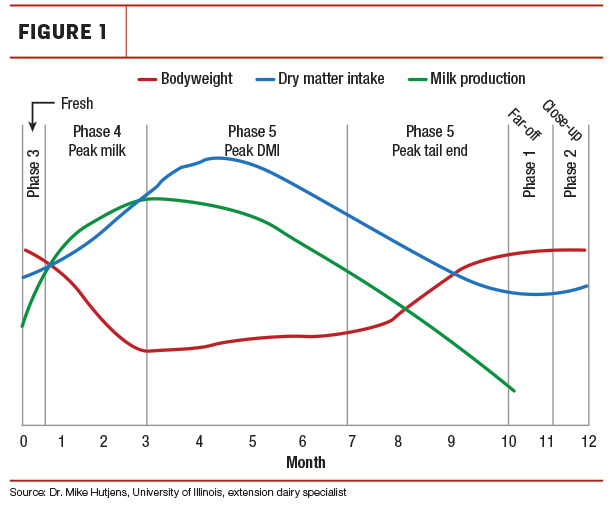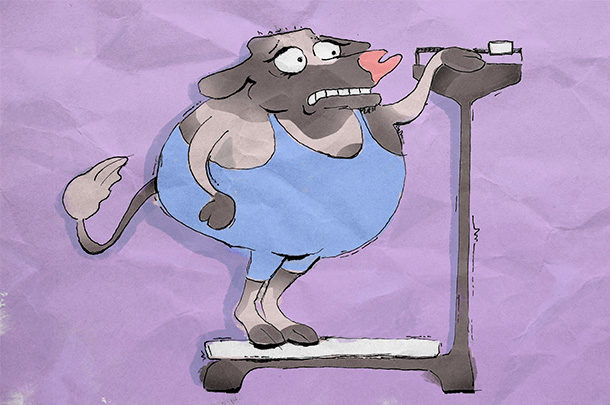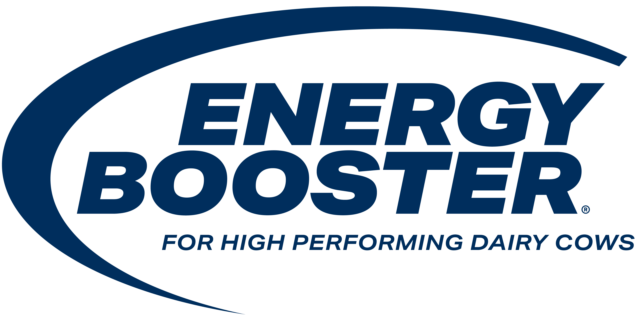Ideal weight is relative term across many species. Take humans, for example. Experts have developed an ideal body mass index based on population averages that indicates whether a person is at an ideal weight for their height.
Interventions are suggested if people fall outside of a certain deviation from those indexes. Some people function perfectly fine outside of their ideal range, while others struggle with health issues related to their weight, perhaps somewhat due to their genetic makeup. The important thing is to know your weight, what your ideal healthy weight should be, then adjust your diet and exercise to maintain that weight.
On a growth path
It’s the same for your dairy herd. From the time calves are born until they freshen, they are on a growth path that will take them to an ideal mature weight. That weight is fairly constant depending on breed but does fluctuate herd by herd. Ideally, heifers will freshen at around 85% of the herd’s average mature weight. They’ll continue to grow and add weight through the first lactation and eventually reach their mature weight after they’ve had their second calf.
Up until cows freshen with their first calf, the name of the game is adding weight at a healthy rate. Once cows calve, their bodyweight curve is in inverse relation to their lactation and dry matter intake (DMI) curves (Figure 1). Bodyweight drops immediately after calving and doesn’t come back until about 100 days in milk. Cows should regain their pre-calving bodyweight somewhere in their last few months of lactation as production and DMI tail off.

Optimally, cows will freshen between 3.25 and 3.75 body condition score (BCS) depending on their age and breed. Cows can lose up to 3% to 3.5% of their bodyweight post calving, or half of a BCS point, in the first 80 days of lactation as energy put toward heavy milk production steals body reserves. If cows calve in with an adequate body condition, there should be enough body reserves to help them get through this period of weight loss.
Don’t deviate from the pattern
If cows stay within this normal pattern of weight loss, there shouldn’t be an issue. But challenges come up if they deviate from this path. If a cow loses 5% or more of her bodyweight, then an intervention needs to take place to understand why. Lameness issues and metabolic disorders, including subclinical mastitis, ketosis, displaced abomasum and other disorders, could be the culprit. If the weight loss persists, poor reproductive performance can be a concern.
If cows lose weight but appear to be in normal health after calving, then an adjustment to the voluntary waiting period (VWP) is likely warranted. Cows that are milking heavy and losing weight aren’t likely to breed back right away, so extending the VWP would be in order.
If cows don’t lose weight, that could be an indicator of suboptimal efficiency and performance. Management decisions could be used to either breed these animals to beef or add them to the do-not-breed list and cull them once they fall below break-even production.
Certainly, understanding weight fluctuations in your herd is important. The questions is, how do you know for sure where your cows are from a weight-loss standpoint? BCS can be an indicator, but it centers more on understanding body reserves rather than bodyweight.
Cow weight tells the story
The only objective way to observe weight changes is to weigh cows on a regular basis. Unfortunately, not many producers take the time or have the resources to weigh cattle. Yet, technology is available to make it easier to weigh cows and manage the data to make more-informed management decisions. Walk-over scales are available that can be placed in exit alleys from the milking parlor. RFID readers identify each cow as they pass over the scale. Manny Salcedo, president of the Dairy Performance Network, tracks weight loss in cows and has developed an algorithm that aligns cow weight to what the cow is producing in milk on a daily basis to identify if the cow is within an acceptable weight-loss range. Any cow that falls outside the range is flagged for further attention.
Cow weight data can be used in several ways, starting with benchmarks established for individual cows and pens of cows within each herd. Individual weights can identify if a health event is imminent and trigger an intervention that will help her manage the health challenge. Additionally, weights can be analyzed across pens of cows by nutritionists to determine if ration adjustments are needed to account for too much or not enough weight loss. Finally, if you want your heifers to reach calving at 85% of mature weight, you need to be accurate about that mature weight so you can set a target goal for heifer development.
More reasons to weigh
Accurate weights are also important from a health standpoint to make sure antibiotics and other treatments are given at the proper dosage. Sometimes inaccurate levels of a medication are administered when blanket doses are given based on an animal’s life stage. Knowing the weight of the animal allows for more accurate dosing and more judicious use of antibiotics.
Dr. Jeffrey Bewley, dairy analytics and innovation scientist with Holstein Association USA, says there is a genetic component as well. Ideally cows would calve and lose a minimal amount of weight and still achieve high production, which would be a mark of a more efficient cow. Weight data could be collected and contributed to a genetic evaluation system to help identify these cows and add them as part of a genetic advancement program.
Understanding weight fluctuations in your herd is important and shouldn’t be left up to subjective analysis. Technology is available now to seamlessly collect individual weight data and make management decisions based on what these data provide.







